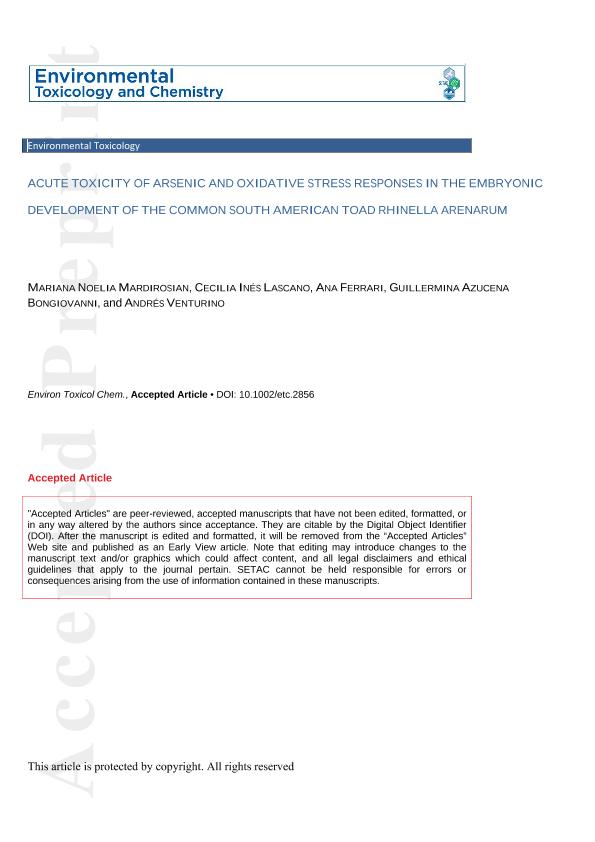Artículo
Acute toxicity of arsenic and oxidative stress responses in the embryonic development of the common South American toad Rhinella arenarum
Mardirosian, Mariana Noelia ; Lascano, Cecilia Ines
; Lascano, Cecilia Ines ; Ferrari, Ana
; Ferrari, Ana ; Bongiovanni, Guillermina Azucena
; Bongiovanni, Guillermina Azucena ; Venturino, Andres
; Venturino, Andres
 ; Lascano, Cecilia Ines
; Lascano, Cecilia Ines ; Ferrari, Ana
; Ferrari, Ana ; Bongiovanni, Guillermina Azucena
; Bongiovanni, Guillermina Azucena ; Venturino, Andres
; Venturino, Andres
Fecha de publicación:
05/2015
Editorial:
Society of Environmental Toxicology and Chemistry
Revista:
Environmental Toxicology and Chemistry
ISSN:
0730-7268
Idioma:
Inglés
Tipo de recurso:
Artículo publicado
Clasificación temática:
Resumen
Arsenic (As), a natural element of ecological relevance, is found in natural water sources throughout Argentina in concentrations between 0.01mg/L and 15mg/L. The autochthonous toad Rhinella arenarum was selected to study the acute toxicity of As and the biochemical responses elicited by the exposure to As in water during its embryonic development. The median lethal concentration (LC50) value averaged 24.3mg/L As and remained constant along the embryonic development. However, As toxicity drastically decreased when embryos were exposed from heartbeat-stage on day 4 of development, suggesting the onset of detoxification mechanisms. Given the environmental concentrations of As in Argentina, there is a probability of exceeding lethal levels at 1% of sites. Arsenic at sublethal concentrations caused a significant decrease in the total antioxidant potential but generated an increase in endogenous glutathione (GSH) content and glutathione S-transferase (GST) activity. This protective response might prevent a deeper decline in the antioxidant system and further oxidative damage. Alternatively, it might be linked to As conjugation with GSH for its excretion. The authors conclude that toad embryos are more sensitive to As during early developmental stages and that relatively high concentrations of this toxic element are required to elicit mortality, but oxidative stress may be an adverse effect at sublethal concentrations.
Archivos asociados
Licencia
Identificadores
Colecciones
Articulos(CCT - PATAGONIA NORTE)
Articulos de CTRO.CIENTIFICO TECNOL.CONICET - PATAGONIA NORTE
Articulos de CTRO.CIENTIFICO TECNOL.CONICET - PATAGONIA NORTE
Articulos(PROBIEN)
Articulos de INST. DE INVESTIGACION Y DES. EN ING. DE PROCESOS, BIOTECNOLOGIA Y ENERGIAS ALTERNATIVAS
Articulos de INST. DE INVESTIGACION Y DES. EN ING. DE PROCESOS, BIOTECNOLOGIA Y ENERGIAS ALTERNATIVAS
Citación
Mardirosian, Mariana Noelia; Lascano, Cecilia Ines; Ferrari, Ana; Bongiovanni, Guillermina Azucena; Venturino, Andres; Acute toxicity of arsenic and oxidative stress responses in the embryonic development of the common South American toad Rhinella arenarum; Society of Environmental Toxicology and Chemistry; Environmental Toxicology and Chemistry; 34; 5; 5-2015; 1009-1014
Compartir
Altmétricas



